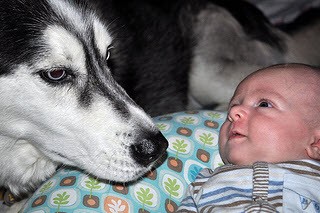For many households, the “first child” is a puppy. That little furry friend is showered with lots of love, indulged (spoiled), and given all the wonderful attention deserved by any first child, human or otherwise. Then, one day, that dog’s family brings home a new bundle of joy in the form of a tiny human brother or sister. This can be the start of a beautiful new friendship for your dog, but it can also be a stressful time of significant adjustment. Here are our recommendations for introducing a new baby brother or sister to your dog.
Make Sure Your Dog is Comfortable Around Others
Raising your dog to be comfortable with other people and pets is an excellent way to start. Your dog will then be more comfortable with new people and pets passing through your home and taking your attention. Your dog will realize that he or she is not always the star of the show. Obedience training, well-run and safe doggie daycare programs and dog parks, and just hanging out with your friends and neighbors are all excellent ways in which to develop your dog’s good manners and social skills.
Getting Your Dog Ready for a New Addition
How will your dog react to the newest member of the family? Dogs are often frightened by little people, but they are also naturally curious. Think about it from a dog’s perspective – they’re used to hanging around with full-sized people who generally don’t make much noise and get around on their own two feet. Then, all of a sudden, this tiny creature that is prone to making a lot of very loud noise and smelling very strange is in their space and taking the attention of their people. It can be overwhelming and confusing for your dog.

Before you bring home your dog’s new sibling, start by introducing your dog to the idea of a baby by carrying around a lifelike baby doll, talking to the doll, and showing the dog that the baby will be in a crib, carrying seat, and in your arms. You can also get recordings of babies (including loud screaming and crying) to play them while your dog is around. If your dog shows any curiosity towards the doll or the sounds, reward him or her with plenty of praise and even treats.
Before your baby comes home, you should also address any potentially dangerous behaviors like jumping, food or toy possessiveness, and romping around on furniture where the new baby might be resting. Your veterinarian or a professional trainer can suggest methods to curb these behaviors.
The Big Day
Your dog is going to be very curious and excited when you bring home your new addition. It will be a sensory overload for him – new smells, sounds, and changes in your behavior. Let your dog join the fun, but in a controlled way. Encourage him to smell and look at his new brother or sister. When he shows calm interest, tell your dog what a great job he’s doing and give him ample treats or a favorite toy as a reward.
During the entire process of introducing your children (regardless of species), be sure to tell your dog that he or she is doing a great job and show lots of love. That’s really what your dog wants more than anything else, and it will help him adjust to the happy additions to your family.
If your dog shows any signs of aggression, anxiety, or other undesirable behavior, address it right away. And again, your veterinarian or trainer can be a wonderful resource to help everyone adjust to the new and wonderful addition in your home.
For information about introducing new pets to your home, check out our article about multi-pet households.
If you have any questions or concerns, you should always visit or call your veterinarian – they are your best resource to ensure the health and well-being of your pets.
